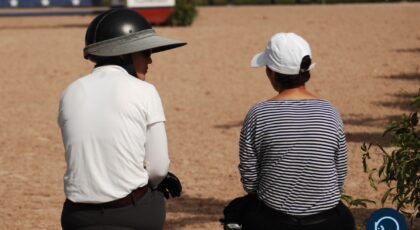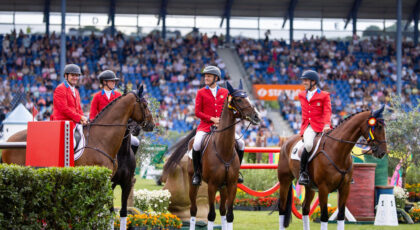It didn’t take long into the drive to feel that familiar catch of a lump in my throat.
I felt queasy, paranoid. I was bracing with white knuckles against the steering wheel, just waiting for something bad to happen.
I was on my way to Ocala with my horse in the trailer hitched behind the truck. It wasn’t the drive that made me nervous—it’s a trek I’d done a million times before. But I couldn’t shake the feeling of doom and gloom.
About a year before, I’d had a panic attack on a highway.
I was driving to meet my veterinarian at the barn. My Thoroughbred gelding had torn a ligament just below his front right ankle, and every ultrasound check up since filled me with dread. My horse had recently re-torn that ligament. After many months of rest, expensive therapies and excruciatingly slow healing, we were starting all over.
There’s never a guarantee of a return to soundness with these types of injuries. But everything felt pretty damn bleak on the day I heaved for air, with tears in my eyes and snot running from my nose, alone in my truck on the shoulder of the expressway.
We’d come a long way since that lowest of lows a year ago.
My horse was finally sound. We were slowly building fitness and returning to a more normal routine. I had entered our first horse show in two years since this serious injury first sidelined us. We loaded up and were on our way.
The hole in my horse’s ligament fibers may have mended, but the trauma of that experience left a void in me that felt like it would never fill.
For so long, I’d cared for my horse never knowing if he’d take a sound step again, let alone return to any kind of ridden work. His eventing days were surely behind him. But all that mattered during this upside-down period was seeing the light at the end of that very long tunnel—would he ever recover? Could he ever just go back to being a horse, free of pain, outside in a pasture with friends?
My vet answered so many of my sobbing phone calls, talking me off the ledge when I waffled on the decisions I made for my horse’s care. I second guessed everything. I never knew if I was doing the right thing at the right time for him.
I’m lucky to have a barn full of equestrian friends, many who shared their horses with me during this time. But I also never felt more lonely than I did then.
Friends could offer a hug or a few words of support. Trainers offered advice, from euthanasia to full-on retirement board. But nobody could tell me what was the right thing to do next.
My non-horsey family was flabbergasted by my depression. I cringed when they asked questions like, “can’t you just get another one?” My husband eventually sat me down one day intervention-style, and begged me to see a grief counselor.
Through it all, I stayed the course. I listened to my vet. I celebrated the little moments, and tried not to get greedy when we’d see a glimmer of hope on the black-and-white ultrasound screen.
I hung on through the rough months that came with rehab. My horse was finally sound, but basically feral.
And slowly, we found each other again.
My vet considers us a success story. We did ultimately recover from the injury. But I still feel that sense of dread too often. I still feel lonely when it comes over me—it’s hard to explain to anyone, people who know horses or not, how it makes you feel.
And even today, on the way to our first horse show, that feeling is there, lurking. This should be a moment of joy. We made it. But the fear of reinjury is never far away.
Despite this, I’m trying to be grateful. And I’m hoping with time, like with my horse’s agonizing, slow recovery, my heart will rebound, too.
Are you an amateur rider with a story to tell? Write to us at news@horsenetwork.com!


 May 7, 2024
May 7, 2024 
























